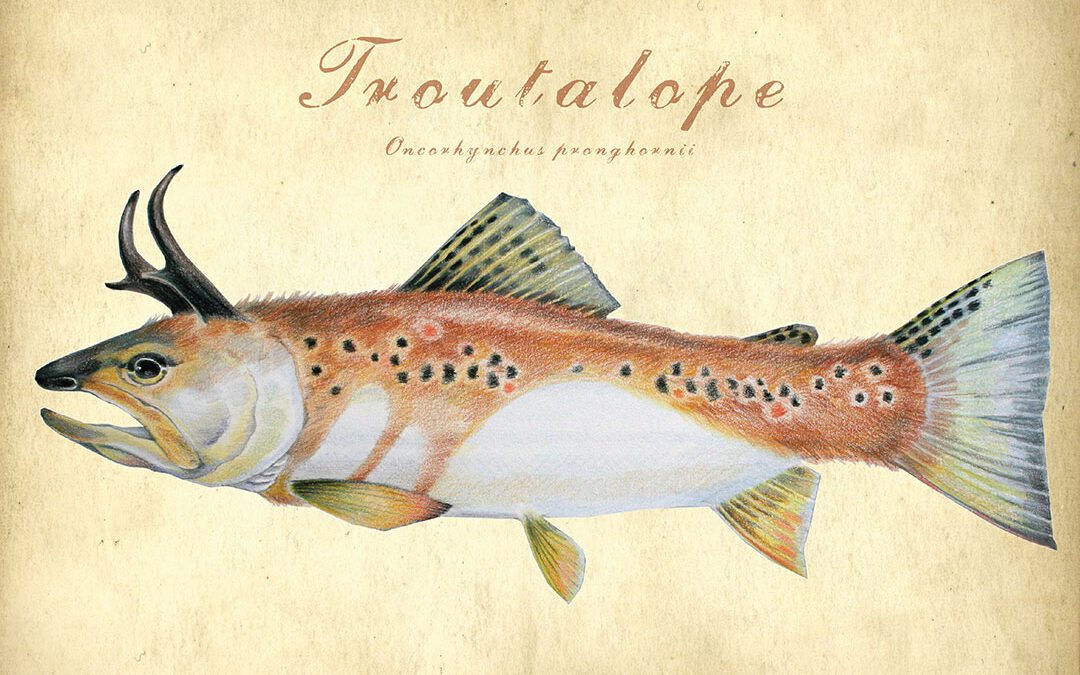Genus: Oncorkynchus pronghornii
Habitat: Wide-open spaces inland American West
Life History: Contrary to common opinion, the troutalope is not rare. In fact, thousands of people have a stuffed one in the garage, bagged with other incredible junk headed to the Salvation Army.
Oh, sorry, about that. We were thinking of the jackalope, not the troutalope.
Jackalopes are elusive but not rare; not so the troutalope. More in a minute.
The very common jackalope is a mythical animal of North American folklore whose origins date back to the Depression years of the 1930s when an underemployed taxidermist in Wyoming (Douglas Herrick, 1920-2003) decided to mount antelope and small deer horns on stuffed jackrabbit heads and sell them to East Coast tourists, like the New Yorker passing through Wyoming in 1935, who spied a Lepus temperamentalus in a souvenir shop.
Tourist: “Wow! These things really exist?”
Curio Dealer: “Watching them mate is the most fun.”
Tourist: (a little embarrassed): “When that happens, which is on top?”
Dealer: “Well, it ain’t the rabbit.”
The jackalope’s life history is well known. Born the offspring of a pygmy antelope and a “killer” rabbit, jackalopes are extremely shy, can be milked (they sleep on their backs and enjoy the fondling), and can be caught with a bottle of Irish whisky.
President Ronald Reagan was given a mounted jackalope by Senator James Abdnor in 1986, but it is not known whether this was just a ceremonial gesture, or if the two had been granted hunting licenses and collected the animal legally out in the sage-brush flats far west of the capital to court the gun-rights vote.
We do know that all politicians are hunters when voting season opens and the NRA reaches for its checkbook. In 1993 Bill Clinton bought a hunting license, dressed up in camo, donned waders, and borrowed a Winchester shotgun to go duck hunting. He spent two hours—count them—waiting for a mallard duck to show up. Among the party, a single duck was shot, but the President said he never inhaled—oh sorry, never pulled the trigger.
Troutalope? Are we making this up?
Of course we are not making this fish up. Truth be known, they still swim freely in many western streams and a few rivers. But they are never caught. Hooked, yes; landed, no. And here’s why.
First, only people with subnormal intelligence are allowed to fish for them legally. And, with an IQ at or below 75, these people are simply too smart to take up fly fishing in the first place.
Second, troutalope are such strong fighters that should a fly fisherman actually hook one, the odds are 1,000 to one against the fish ever being landed. Maybe higher. More than a few anglers have been pulled into deep pools and drowned by these fish—then later found with a broken rod in hand and a grin frozen on their lips.
Why are these fish so strong?
We don’t know, but we do know that intelligent fly fishers who target them (illegally) often spend weeks in the Bahamas practicing on tarpon before attempting to take a troutalope.
As one veteran put it: “If you tie a hundred-pound tarpon tail-to-tail with a three-pound troutalope and drop them in the water at the same time, the tarpon will be pulled backward so fast all his scales will fly off.”
Of some several hundred troutalope hookups, maybe two are ever netted. The rest straighten hooks or break off. And even when brought to the knee for netting, you guessed it, they use their horns to tear a hole in the net to escape.
In one reported case, a fly fisherman claims to have been jabbed in the thigh by a 12-inch horned troutalope while kneeling to land it. The stabbing holed his waders, punctured his skin, and sent him to a nearby tavern for medical care where, amid a crowd of skeptics, he attempted to explain how something that looked like a cross between a trout and an antelope had broken his rod and drawn blood.
Sadly, our hero was not successful in convincing his audience about what had happened, but at least he did not have to pay for his own beer. Following the guffaws and eye rolls, the bartender cried, “The troutalope strikes again, lads! The drinks are on me!”
Some troutalope experts say that new rules may be needed to actually catch these fish.
One example comes from the Alaska commercial fishing fleet, where halibut in excess of 80 pounds are slain by shotgun lest their flopping around on deck breaks someone’s legs. Naturally the question has now arisen in fish and game departments all over the West: “Should fly fishers be permitted to use large-caliber firearms to dispatch troutalope before attempting to land them!”
Opinions vary, but fly shop owners are united against any such nonsense. As one owner put it, “Selling flies is a living; selling rods is a nice living. Brook trout don’t break rods, and troutalope do. Killing them would pose a serious threat to our industry.”

One final story: It is rumored—only rumored—that Ernest Hemingway hooked several troutalope in his home waters around Sun Valley, Idaho, toward the end of his life.
But he never landed one.
Already depressed, his writing career in shambles, we can only imagine how the legendary author must have felt after being humiliated by a little trout. In his power years he had taken great marlin off the stern of the Pilar out in the Gulf Stream west of Bimini while hunting Nazi submarines, and yet here was a bait-sized snippet of a trout mangling his fly rods.
An alleged conversation with the literary giant after a day on the Henry’s Fork of the Snake:
“So Papa, how was fishing?”
“Pretty good. Four browns, two cutthroats, a rainbow . . . and one son-of-a-bitch that broke my rod.”
“What could be strong enough to break your rod?”
Hemingway: “Hard to tell. Just slammed my fly and took off. Jumped twice and snapped the bamboo. It was a very good fish and I wanted badly to land it. It was all a fish should be, and more.”
Then, with the sad eyes of a beaten man, Papa reached for glass of whisky and said, “The damn thing had horns.”
If You Want To Go
Where?
Most any river traveled by Lewis and Clark back in 1805, when the trout were plentiful and ran in great numbers throughout the drainages of the Great Rocky Mountains. They like seam water, slow-moving, about four feet deep below wide riffles. We’re talking the Madison, Jefferson, Yellowstone, Clark Fort, Bitterroot, Rock Creek, and waters west and south. As you know, this is drift water. These rivers are very popular among anglers from all over the world and can sometimes get a little crowded, what with people fishing on top of each other, tangling their lines and such. We therefore recommend a special mob-dispersal system unique to those stalking the troutalope. Even if you do not intend to do dangerous things to people, we think you should dress like you could, so here’s the drift boat outfit we recommend. Ray-Ban sunglasses, studded-leather vest over a white Bedouin tunic, three feet of flowing fake pink hair held in place with a Sherlock Holmes deerstalker cap, and a bandolier of .50-caliber machine gun ammo slung crosswise over your chest. If you have room, mount a .50-caliber heavy machine gun on your boat—on the stern, of course, so you don’t snag your line while casting.
Gear?
We just covered it. Oh, don’t forget a rod, reel, and line.
Fly?
Rocky Hoppers when trout are picky and going large. When you are finally done fooling around with this, fall back on your #12 Adams. Just as a shotgun is useful in identifying birds too small to see with binoculars, your Adams may get something when all else fails.

Fast & Horny
1 lime wedge
1/4 oz. real maple syrup
1” piece of unpeeled cucumber
2 oz. aged Mezcal
1/2 oz. Chartreuse
Muddle lime, cucumber, and sage until pulpy in a tumbler. Swirl in mezcal, chartreuse, and maple syrup. Shake with ice, then double strain over ice into glass. Float sage leaf to garnish.

